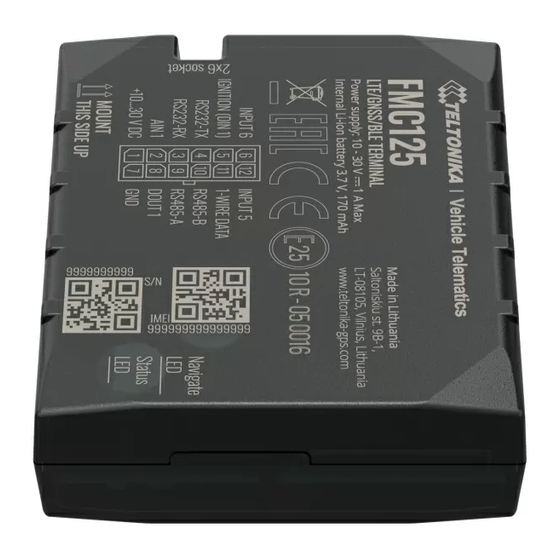
Teltonika FMB125 Getting Started
Hide thumbs
Also See for FMB125:
- Quick manual (21 pages) ,
- First start-up quick start manual (9 pages) ,
- Manual (3 pages)
Table of Contents
Advertisement
Quick Links
https://wiki.teltonika-gps.com/view/FMB125_Getting_Started_with_AWS_IoT_Core
FMB125 Getting Started with AWS IoT Core
Main Page
>
Professional Trackers
Contents
1 Document Information
1.1 Glossary
1.2 Revision History (Version, Date, Description of change)
7 Other software required to develop and debug applications for the device
14 Troubleshooting
15 Debugging
Document Information
Glossary
FMB125 (tracker) - GNSS tracking device manufactured by Teltonika Telematics.
Wiki - Teltonika IoT knowledge base - https://wiki.teltonika-iot-group.com/.
FOTA - Firmware Over The Air.
>
FMB125
>
FMB125 Manual
> FMB125 Getting Started with AWS IoT Core
Advertisement
Table of Contents

Subscribe to Our Youtube Channel
Summary of Contents for Teltonika FMB125
-
Page 1: Table Of Contents
11 Checking received data and sending commands in the AWS IoT core 12 Debugging 13 Troubleshooting 14 Troubleshooting 15 Debugging Document Information Glossary FMB125 (tracker) – GNSS tracking device manufactured by Teltonika Telematics. Wiki – Teltonika IoT knowledge base - https://wiki.teltonika-iot-group.com/. FOTA – Firmware Over The Air. -
Page 2: Overview
This device is perfectly suitable for applications where location acquirement of remote objects is needed: fleet management, car rental companies, taxi companies, public transport, logistics companies, personal cars and so on. FMB125 can perform tasks on remote objects, such as monitoring engine status, controlling truck’s door etc. -
Page 3: Set Up Your Development Environment
Set up your Development Environment Tools Installation (IDEs, Toolchains, SDKs) FMB125 comes with our created firmware, therefore no additional development or scripting is required for this unit to support AWS IoT. Only by using Teltonika Configurator FM Configurator versions, connection point of AWS IoT server is required. -
Page 4: Create Resources In Aws Iot
Sign up for an AWS account Create a user and grant permissions Open the AWS IoT console Pay special attention to the Notes. Create Resources in AWS IoT Refer to the online AWS documentation at Create AWS IoT Resources. Follow the steps outlined in these sections to provision resources for your device: Create an AWS IoT Policy Create a thing object... - Page 5 Figure 1. Accessing AWS IoT core from AWS console NOTE: If you can't see "Services" in the top left, click on "My account" in the top right and "AWS Management Console" Select Manage, Security, Policies (Manage > Security > Policies) and press Create policy or Create buttons.
- Page 6 Figure 5. Creating single thing After creating a single thing, enter Thing’s name and in the Device Shadow tab select Unnamed shadow (classic). Then click Next. Figure 6. Thing's properties Then when selecting Device certificate, select Auto-generate a new certificate and click Next.
- Page 7 Figure 7. Certificate configuration Now, select the policy you have created before to attach it to the certificate and thing. After that click Create thing. Figure 8. Attaching policy to certificate Then window with Certificate files and key files download options should pop out. It‘s recommended to download all files, because later some of them will not be available for download.
-
Page 8: Finding Device Data Endpoint (Server Domain)
Figure 9. Certificate and key download Finding device data endpoint (server domain) To receive server domain (in AWS endpoint) click on the side bar on the left Settings (AWS IoT->Settings). Or click on the side bar on left side Things, select the created thing, after it click Interact->View Settings. -
Page 9: Security And Certificates
Thing in AWS IoT Core. Figure 17. Certificate, private key and root certificate Upload the mentioned files in the Security tab in the Teltonika Configurator. Figure 18. Uploading certificates and keys After uploading certificates, go to System tab and in Data protocol section select - Codec JSON. -
Page 10: Device Gprs Configuration For Aws Iot Custom Mqtt Settings
Figure 19. Choosing data protocol Device GPRS configuration for AWS IoT Custom MQTT settings In the GPRS tab, under Server Settings select: Domain – Endpoint from the AWS, Port: 8883 Protocol – MQTT TLS Encryption – TLS/DTLS In the MQTT Settings section select: MQTT Client Type –... - Page 11 Figure 29. MQTT test client Incoming data is received in JSON format, for e.g.: Figure 30. Received data format To send SMS/GPRS commands to the device subscribe to a topic name - *DeviceIMEI*/commands, and, in the same MQTT test client window select Publish to a topic. Enter topic name - *DeviceIMEI*/commands.
-
Page 12: Debugging
USB connection port, or by receiving internal logs via FotaWEB in task section. Troubleshooting The information can be submitted to Teltonika HelpDesk and Teltonika engineers will assist with troubleshooting. For a more detailed information regarding what information should be collected for debugging, please visit the dedicated page on Teltonika Wiki.














Need help?
Do you have a question about the FMB125 and is the answer not in the manual?
Questions and answers